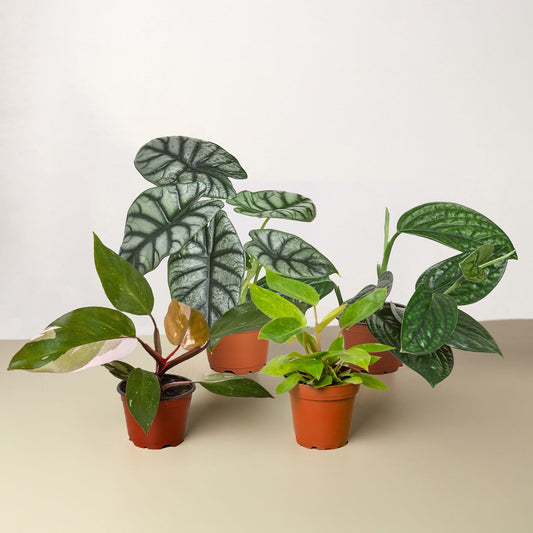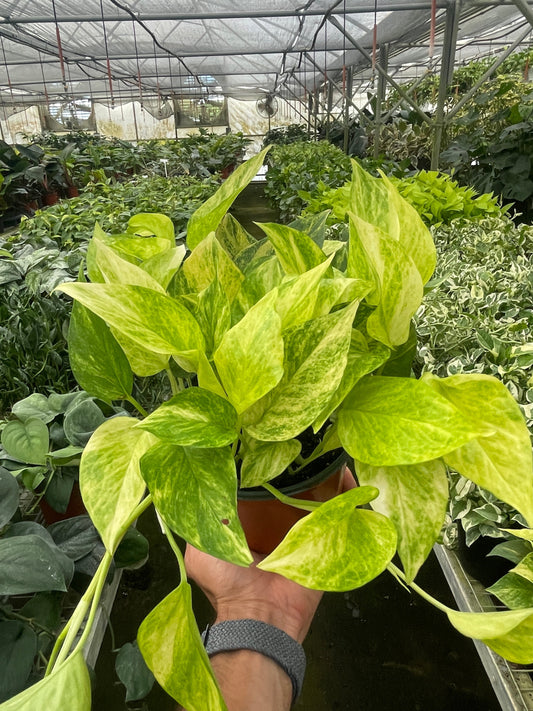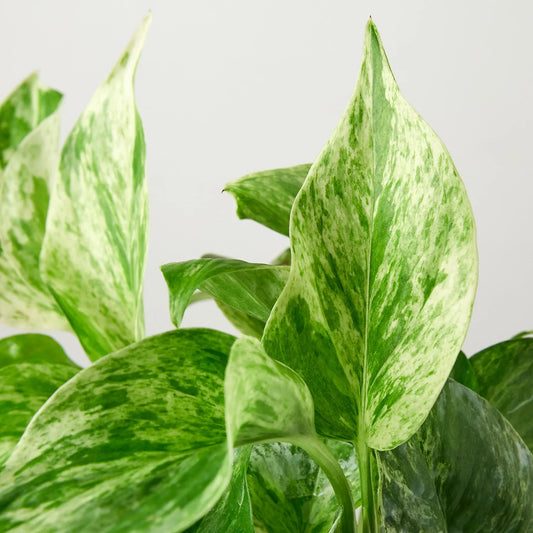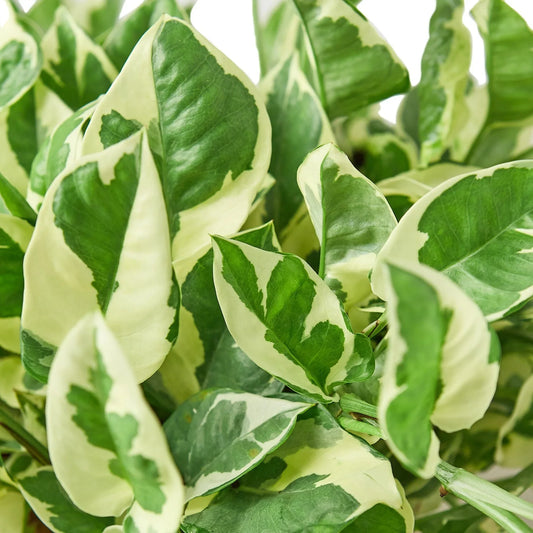Common N'Joy Pothos Diseases (And How To Treat Them)
Cafe Planta Team
Ah, the N'Joy Pothos—a delightful addition to any indoor garden. With its striking variegated leaves and effortless charm, it's no wonder this plant is a favorite among plant people. But even the most robust plants can run into trouble, and the N'Joy Pothos is no exception. From pesky pests to fungal foes, a few common issues might crop up in your plant's journey.
In this article, we're going to chat about some of the most frequent diseases and issues your N'Joy Pothos might face. Don't worry—I'll also share some straightforward solutions to help you keep your leafy friend thriving. So, grab a cup of tea, pull up a comfy chair, and let's get started on this plant care adventure!
Root Rot: The Silent Killer
Root rot is one of the most common ailments for many houseplants, including the N'Joy Pothos. It usually sneaks up when your plant sits in waterlogged soil for too long. If you've noticed your Pothos looking a bit droopy or its leaves turning yellow, root rot might be the culprit.
To check for root rot, gently remove your plant from its pot and take a look at the roots. Healthy roots should be white and firm, while rotted ones will appear brown, mushy, and might even have an unpleasant smell. If you find rot, don't panic—there's still hope!
- First, trim away any affected roots using sterilized scissors or pruners.
- Repot your plant in fresh, well-draining soil to prevent further issues.
- Ensure your pot has drainage holes to allow excess water to escape.
- Adjust your watering schedule. Let the top inch of soil dry out before watering again.
With a little TLC, your N'Joy Pothos can bounce back from root rot and continue to grow happily.
Leaf Spot Disease: Those Pesky Spots
Leaf spot disease can be a real nuisance. It often starts as small, dark spots on the leaves and can quickly spread if not addressed. This condition is usually caused by fungal or bacterial pathogens, often exacerbated by high humidity and poor air circulation.
If you notice spots on your Pothos leaves, here are a few steps you can take to manage the issue:
- Remove any affected leaves to prevent the disease from spreading.
- Ensure your plant is in a well-ventilated area to reduce humidity around the leaves.
- Water your plant at the base to avoid wetting the leaves, which can encourage fungal growth.
- Consider using a fungicide as a last resort, but always follow the manufacturer's instructions carefully.
By taking these steps, you can help your N'Joy Pothos recover from leaf spot disease and minimize the chance of recurrence.
Powdery Mildew: A Dusty Dilemma
Powdery mildew is another fungal issue that can affect your N'Joy Pothos. If you notice a white, powdery substance on the leaves, you've likely got a case of powdery mildew on your hands. This fungus thrives in warm, dry conditions, which makes it a bit tricky since you might not notice it until it's well established.
Here's how to tackle powdery mildew:
- Remove any heavily infected leaves to stop the spread.
- Increase ventilation around your plant to reduce humidity.
- Try a homemade remedy, such as a mixture of baking soda and water, to gently remove the mildew.
- If needed, use a commercial fungicide, but always check the label for safety and usage guidelines.
With prompt action, you can rid your Pothos of powdery mildew and keep it looking its best.
Pest Problems: The Unwanted Guests
Sometimes, pests like to take up residence on your N'Joy Pothos. Common culprits include spider mites, aphids, and mealybugs. These pests can cause a range of symptoms, from webbing and discolored leaves to stunted growth.
To keep these pests at bay, consider the following steps:
- Inspect your plant regularly for signs of pests.
- Use a gentle stream of water to wash off any visible pests.
- Consider using insecticidal soap or neem oil as a natural pest control option.
- Increase humidity around your plant, as many pests thrive in dry conditions.
Consistent monitoring and quick intervention can help prevent a minor pest problem from becoming a major headache.
Overwatering: A Common Mistake
Overwatering is a frequent issue among plant parents, and the N'Joy Pothos is no exception. This plant prefers its soil to dry out a bit between waterings, so keeping it too soggy can lead to problems like root rot or yellowing leaves.
To avoid overwatering, try these tips:
- Stick your finger into the soil to check moisture levels. Water only when the top inch feels dry.
- Ensure your pot has drainage holes, allowing excess water to escape.
- Consider using a moisture meter to get a more accurate reading of the soil's moisture content.
By adjusting your watering habits, you can help your N'Joy Pothos thrive without overwatering.
Underwatering: Finding the Right Balance
On the flip side, underwatering can also pose a challenge. If your Pothos is droopy, with dry and crispy leaves, it might be crying out for a drink.
To ensure your plant gets enough water, follow these suggestions:
- Water your plant thoroughly, allowing the excess to drain away.
- Keep an eye on your plant's leaves—they can be a great indicator of when it needs water.
- Consider setting a regular watering schedule, but always adjust based on your plant's needs and the environment.
By finding the right balance, you can keep your N'Joy Pothos happy and hydrated.
Nutrient Deficiency: Feeding Your Pothos
Sometimes, your N'Joy Pothos might suffer from a lack of nutrients, which can show up as pale or yellowing leaves and stunted growth. This could be due to insufficient fertilization or poor soil quality.
To ensure your plant gets the nutrients it needs, consider the following:
- Feed your plant with a balanced, water-soluble fertilizer every 4-6 weeks during the growing season.
- Repot your plant every couple of years to refresh the soil and provide new nutrients.
- Monitor for signs of over-fertilization, such as leaf burn, and adjust the feeding schedule as needed.
By providing the right nutrients, you can support your Pothos in growing strong and healthy.
Sunburn: Too Much of a Good Thing
While N'Joy Pothos loves bright, indirect light, too much direct sunlight can lead to sunburn. If you notice brown, crispy patches on the leaves, your plant might be getting too much sun.
To prevent sunburn, try these tips:
- Move your plant to a location with bright, indirect light.
- Use sheer curtains to filter harsh sunlight if your plant sits near a south-facing window.
- Rotate your plant regularly to ensure even light exposure.
With a bit of adjustment, you can protect your N'Joy Pothos from sunburn and keep its leaves looking vibrant.
Humidity Levels: Creating the Perfect Atmosphere
N'Joy Pothos can tolerate a range of humidity levels, but they thrive in a slightly humid environment. If the air in your home is too dry, your plant might develop brown leaf tips or edges.
To boost humidity, consider these options:
- Place a humidifier nearby to increase moisture in the air.
- Group your plants together to create a microclimate with higher humidity.
- Occasionally mist your plant's leaves, but avoid overdoing it to prevent fungal issues.
By maintaining the right humidity, you can create an ideal environment for your N'Joy Pothos to flourish.
Final Thoughts
Caring for a N'Joy Pothos doesn't have to be overwhelming. By keeping an eye out for common issues like root rot, leaf spot disease, and pest infestations, you can take proactive steps to address them. With the right care and attention, your Pothos will reward you with lush, vibrant foliage.
At Cafe Planta, we're all about helping you care for your plants. Whether you're looking for new plants to add to your collection or need advice on plant care, we're here to help. Feel free to email us or reach out on Instagram. We believe that plants have the power to bring people together, and we're excited to share our love of plants with you.



















